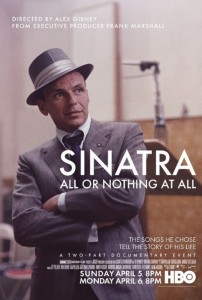 Start spreading the news. It’s been 100 years since the birth of one of the most famous people in American pop culture–and the family of Frank Sinatra wanted to mark the centennial of the legendary crooner’s birthday in a big way befitting his iconic status.
Start spreading the news. It’s been 100 years since the birth of one of the most famous people in American pop culture–and the family of Frank Sinatra wanted to mark the centennial of the legendary crooner’s birthday in a big way befitting his iconic status.
So they called upon producer Frank Marshall, best known for blockbuster films like “Indiana Jones” and “Raiders of the Lost Ark” and someone who had a unique connection. His father, Jack Marshall had played guitar on some of Sinatra’s Capitol Records recordings in the mid-1950s.
Marshall in turn hired director Alex Gibney, with whom he had worked on a 2013 documentary about Lance Armstrong. Gibney, who has a string of high profile exposés on his credit list including the recent “Going Clear: Scientology and the Prison of Belief,” is also a jazz and music lover who had helmed “Mr. Dynamite: The Rise of James Brown.”
The result: HBO’s upcoming two-night, four-hour presentation of “Sinatra: All or Nothing at All.”
The documentary chronicles Sinatra’s entire life, high points and low moments, beginning with his upbringing in Hoboken, N.J. as the son of Italian immigrants– before tracing his rise to superstardom. Sinatra started out as a singer for the jazz band orchestras of Harry James and Tommy Dorsey in the 1930s before an ultra-successful solo career that led to movie roles and an Academy Award.
“He was a deep and complicated man who had a rough side but was generous and loving,” says Marshall.
The film also hits on the controversies that surrounded Sinatra, including his relationship with the Kennedys, his failed marriages to his first wife Nancy and to movie stars Ava Gardner and Mia Farrow, his exemption from military service during World War II, his politics and his connections to the Mob. It aims to clear up misconceptions that may have developed over the years.
“All or Nothing at All” unfolds based on rarely seen footage of Sinatra’s 11-song set at his intended farewell concert on June 13, 1971. The occasion was a star-studded benefit at the Ahmanson Theatre in Los Angeles for the 50th anniversary of the Motion Picture and Television Relief Fund–a gala produced by Gregory Peck and attended by Barbra Streisand, Cary Grant, Bob Hope, Princess Grace of Monaco, Jack Benny and Jimmy Stewart.
Each song is used as a framework for unspooling the chapters in Sinatra’s life, including words from the singer himself in multiple interview situations. But not only do they represent one person’s life, they signify pivotal moments in American culture, how it evolved and how Sinatra tried to keep up with the changes.
For Gibney, it was a unique way in which to frame a biopic. “It was footage that was fantastic and shot in an unusual way, like cinéma vérité rather than like a network television special,” he said. “But it was also a mystery story. Why would Frank Sinatra decide in 1971 retire– which he didn’t end up doing– and put together this particular song list? He never wrote an autobiography, so it was kind of like an autobiography in song. It was roughly chronological but we also jump back and forth, and it seemed an interesting and poetic way to deal with a biography.”
About 30 people are interviewed, mostly in voiceover, including Sinatra’s children and his wives, as well as Quincy Jones, Harry Belafonte, Mia Farrow, Tony Bennett and Steve Wynn.
“Inevitably, the material is shaped by the voices you include and that’s really true for Frank. We used moments that were particularly powerful to shape the narrative,” Gibney said. “We stay in the moment by using photos and images as the people are recollecting.”
Gibney said he was engaged by two things about Sinatra. “One was his ambition. He was one of the great American characters, coming from Hoboken and making the long trip across the river to New York City and becoming a figure who dominates American culture for 30 years. The other thing that comes out in his ballads is that he’s a storyteller. His songs are like three minute movies. Part of it was technical, using breath control, and the ability to carry a phrase in the way the story demanded it, and part was in the way he performed.”
Lovers of his music will get more than their fill of performance footage throughout the four hours, which includes never-before-seen home movie footage and rare recordings of performances along with Sinatra’s appearances on various television shows over the decades.
(“Sinatra: All or Nothing at All” debuts on HBO April 5 and 6 at 8 p.m. ET/PT.)
–Hillary Atkin

